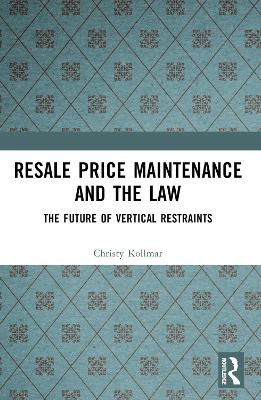Resale Price Maintenance and the Law
 portes grátis
portes grátis
Resale Price Maintenance and the Law
The Future of Vertical Restraints
Kollmar, Christy
Taylor & Francis Ltd
10/2024
426
Mole
9781032315522
Pré-lançamento - envio 15 a 20 dias após a sua edição
Descrição não disponível.
Contents
Preface
List of Abbreviations
List of Annexes and Tables
Chapter 1 Introduction
Abstract
Topic Introduction
Background on Assessment and Application: Legal Issues and Development
Background on Enforcement Best Practices: Investigative Techniques and Enforcement Protocol
Research Objectives and Main Research Questions
Structure and Scope of Book
Conclusory Remarks
PART I - US HISTORICAL ORIGINS AND ECONOMIC FOUNDATIONS
Chapter 2 The Legal and Political Origins of RPM - United States
Abstract
United States: Historical Origins & Legal Structure of RPM
The Introduction of the Sherman Act and its Common Law Roots: 1889-1910
Dr. Miles Era- the Right of Alienation and its Per Se Impact: 1911-1930
Fair Trade Era- Carving out Exceptions to the Sherman Act: 1930-1975
Post Fair Trade Era- Non-Price vs. Price Transition Towards Rule of Reason: 1975 - 2007
Leegin Era- Maximum vs. Minimum RPM Transition Towards Rule of Reason: 2007 - Present
Chapter Conclusion: US Historical Origins and Legal Structure
Chapter 3 The Economics of Vertical Agreements - Background
Abstract
Chapter Introduction
General Economic Background of Vertical Restraints
General Economic Background of RPM
Background on Economic Theories of RPM
Link Between Schools of Thought and Economic Models
General Structure of Models: Vertical and Horizontal Elements of RPM
Digital Single Market, the E-Commerce Sector Inquiry and the Internet
Goals of the EC: Digital Single Market and E-Commerce Sector Inquiry
Models of Change: How the Internet Changed Market Dynamics
Conclusion: RPM Economic Background and E- Commerce
Chapter 4 The Economics of Vertical Agreements - Models
Abstract
Anti-Competitive vs. Pro-competitive Economic Models of RPM
Anti-Competitive RPM Theories
Facilitating Collusion Upstream or Downstream
Increase in Prices, Lifecycles and Product Favouritism
Foreclosure and Restriction of Entry Both Upstream and Downstream
Foreclosure as a Commitment Device in Protection of Monopoly Rents
Dampen or Soften Competition Both Upstream and Downstream
Pro-Competitive RPM Theories
Special Services and Free-riding
Quality Certification and Signalling
Image Theory: The Allure of Paying More
Demand Uncertainty and Inventories
Outlets and Distribution Density
Moral Hazard and Double Moral Hazard
Production of a Good when Manufacturers' Risks are Low
Contract Enforcement Mechanism and Quality Control
Loss Leader Selling
Less Efficient Dealer and/or Distributional Efficiency
Price Discrimination
Spatial Price Discrimination
Where imposing an RPM floor leads to a decrease in collusive behaviour
RPM with Optimal Delegation
New Market Entry or Product Launch
Pro-competitive models which rely on the purely vertical aspect of RPM
Conclusion: No Consensus among Economists on Impact of RPM
PART II - EU HISTORICAL ORIGINS AND LEGAL STRUCTURE
Chapter 5 The Legal and Political Origins of RPM - European Union
Abstract
European Union: Historical Origins & Legal Structure of RPM
Historical Background of EU Vertical Enforcement
Current Legal Structure of EU Vertical Enforcement
Block Exemptions and their role in vertical restraint enforcement
Article 101(3): a closer examination of the individual assessment and its role in vertical restraint enforcement
Chapter Conclusion: EU Historical Origins and Legal Structure
Chapter 6 The Legal Concepts of By-Object, By-Effect and Appreciability
Abstract
Introduction to the Distinction between By-Object and By-Effect
A Background on By-Object Restrictions: The Finer Details
Categorisation and Analysis of By-Object Restrictions: A Deeper Dive
By-Object Categorisation: Overview of Differences between the EC and Case Law Approaches
By-Object Categorisation: Approaches to Appreciability
By-Effect Comparison: A Concise Overview of the Main Differences
Return to the RPM Legal Structure in light of the By-Object/By-Effect Dichotomy: Overview of the Current Approach to RPM Enforcement
Article 101(3): a closer examination of the individual assessment and its role in RPM enforcement
Chapter Conclusion
PART III - PROPOSALS, IMPLICATIONS AND SOLUTIONS
Chapter 7 Proposals and Solutions
Abstract
Chapter Introduction
Time for a Change? Transatlantic Synchrony towards Revealing a Malfunctioning Regime
RPM Legal Regime: Current Challenges undermining its Efficacy
Horizontal Non-consensus: Should NCAs have their own agenda?
A New Way Forward: Developing a More Viable Approach to RPM Enforcement
Proposed RPM Solutions
Solution 1: Escaping automatic Article 101(3) TFEU applicability: developing a mechanism where RPM can be found inappreciable, and therefore, not in violation of Article 101(1) TFEU
Solution 2: Eliminate RPM's hardcore designation by shifting its inclusion in the VBER from Article 4 to Article 5
Solution 3: Elimination of RPM's hardcore designation through its application to Article 2 of the VBER (original and modified case scenarios)
Solution 4: Application of the De Minimus Doctrine to RPM
Solution 5: Recommendations for Improvement of Status Quo
Chapter Conclusion
Chapter 8 Conclusion
Abstract
Conclusion: Most Serious Considerations to Enhance the Efficacy of the Current RPM Regime
Overview of Solutions: The Best Way Forward
Final Remarks
Annex 1 RPM US Origins
Annex 2. RPM Economic Models
Annex 3. RPM Model Timeline
Index
Preface
List of Abbreviations
List of Annexes and Tables
Chapter 1 Introduction
Abstract
Topic Introduction
Background on Assessment and Application: Legal Issues and Development
Background on Enforcement Best Practices: Investigative Techniques and Enforcement Protocol
Research Objectives and Main Research Questions
Structure and Scope of Book
Conclusory Remarks
PART I - US HISTORICAL ORIGINS AND ECONOMIC FOUNDATIONS
Chapter 2 The Legal and Political Origins of RPM - United States
Abstract
United States: Historical Origins & Legal Structure of RPM
The Introduction of the Sherman Act and its Common Law Roots: 1889-1910
Dr. Miles Era- the Right of Alienation and its Per Se Impact: 1911-1930
Fair Trade Era- Carving out Exceptions to the Sherman Act: 1930-1975
Post Fair Trade Era- Non-Price vs. Price Transition Towards Rule of Reason: 1975 - 2007
Leegin Era- Maximum vs. Minimum RPM Transition Towards Rule of Reason: 2007 - Present
Chapter Conclusion: US Historical Origins and Legal Structure
Chapter 3 The Economics of Vertical Agreements - Background
Abstract
Chapter Introduction
General Economic Background of Vertical Restraints
General Economic Background of RPM
Background on Economic Theories of RPM
Link Between Schools of Thought and Economic Models
General Structure of Models: Vertical and Horizontal Elements of RPM
Digital Single Market, the E-Commerce Sector Inquiry and the Internet
Goals of the EC: Digital Single Market and E-Commerce Sector Inquiry
Models of Change: How the Internet Changed Market Dynamics
Conclusion: RPM Economic Background and E- Commerce
Chapter 4 The Economics of Vertical Agreements - Models
Abstract
Anti-Competitive vs. Pro-competitive Economic Models of RPM
Anti-Competitive RPM Theories
Facilitating Collusion Upstream or Downstream
Increase in Prices, Lifecycles and Product Favouritism
Foreclosure and Restriction of Entry Both Upstream and Downstream
Foreclosure as a Commitment Device in Protection of Monopoly Rents
Dampen or Soften Competition Both Upstream and Downstream
Pro-Competitive RPM Theories
Special Services and Free-riding
Quality Certification and Signalling
Image Theory: The Allure of Paying More
Demand Uncertainty and Inventories
Outlets and Distribution Density
Moral Hazard and Double Moral Hazard
Production of a Good when Manufacturers' Risks are Low
Contract Enforcement Mechanism and Quality Control
Loss Leader Selling
Less Efficient Dealer and/or Distributional Efficiency
Price Discrimination
Spatial Price Discrimination
Where imposing an RPM floor leads to a decrease in collusive behaviour
RPM with Optimal Delegation
New Market Entry or Product Launch
Pro-competitive models which rely on the purely vertical aspect of RPM
Conclusion: No Consensus among Economists on Impact of RPM
PART II - EU HISTORICAL ORIGINS AND LEGAL STRUCTURE
Chapter 5 The Legal and Political Origins of RPM - European Union
Abstract
European Union: Historical Origins & Legal Structure of RPM
Historical Background of EU Vertical Enforcement
Current Legal Structure of EU Vertical Enforcement
Block Exemptions and their role in vertical restraint enforcement
Article 101(3): a closer examination of the individual assessment and its role in vertical restraint enforcement
Chapter Conclusion: EU Historical Origins and Legal Structure
Chapter 6 The Legal Concepts of By-Object, By-Effect and Appreciability
Abstract
Introduction to the Distinction between By-Object and By-Effect
A Background on By-Object Restrictions: The Finer Details
Categorisation and Analysis of By-Object Restrictions: A Deeper Dive
By-Object Categorisation: Overview of Differences between the EC and Case Law Approaches
By-Object Categorisation: Approaches to Appreciability
By-Effect Comparison: A Concise Overview of the Main Differences
Return to the RPM Legal Structure in light of the By-Object/By-Effect Dichotomy: Overview of the Current Approach to RPM Enforcement
Article 101(3): a closer examination of the individual assessment and its role in RPM enforcement
Chapter Conclusion
PART III - PROPOSALS, IMPLICATIONS AND SOLUTIONS
Chapter 7 Proposals and Solutions
Abstract
Chapter Introduction
Time for a Change? Transatlantic Synchrony towards Revealing a Malfunctioning Regime
RPM Legal Regime: Current Challenges undermining its Efficacy
Horizontal Non-consensus: Should NCAs have their own agenda?
A New Way Forward: Developing a More Viable Approach to RPM Enforcement
Proposed RPM Solutions
Solution 1: Escaping automatic Article 101(3) TFEU applicability: developing a mechanism where RPM can be found inappreciable, and therefore, not in violation of Article 101(1) TFEU
Solution 2: Eliminate RPM's hardcore designation by shifting its inclusion in the VBER from Article 4 to Article 5
Solution 3: Elimination of RPM's hardcore designation through its application to Article 2 of the VBER (original and modified case scenarios)
Solution 4: Application of the De Minimus Doctrine to RPM
Solution 5: Recommendations for Improvement of Status Quo
Chapter Conclusion
Chapter 8 Conclusion
Abstract
Conclusion: Most Serious Considerations to Enhance the Efficacy of the Current RPM Regime
Overview of Solutions: The Best Way Forward
Final Remarks
Annex 1 RPM US Origins
Annex 2. RPM Economic Models
Annex 3. RPM Model Timeline
Index
Este título pertence ao(s) assunto(s) indicados(s). Para ver outros títulos clique no assunto desejado.
Vertical Restraint;Inter-brand Competition;EU Competition Law;Hardcore Restrictions;Rpm;De Minimis Notice;Vertical Agreements;Harm Consumer Welfare;Intra-brand Competition;EU Competition;EU Competition Policy;Minimum Rpm;Pro-competitive Effects;Consumer Welfare;EU Law;Rpm Agreement;Block Exemption;Vertical Price Restraints;Pre-sale Services;VR Guideline;Downstream Retailers;Dg Comp;Sherman Act;Restrictive Object;Interbrand Competition
Contents
Preface
List of Abbreviations
List of Annexes and Tables
Chapter 1 Introduction
Abstract
Topic Introduction
Background on Assessment and Application: Legal Issues and Development
Background on Enforcement Best Practices: Investigative Techniques and Enforcement Protocol
Research Objectives and Main Research Questions
Structure and Scope of Book
Conclusory Remarks
PART I - US HISTORICAL ORIGINS AND ECONOMIC FOUNDATIONS
Chapter 2 The Legal and Political Origins of RPM - United States
Abstract
United States: Historical Origins & Legal Structure of RPM
The Introduction of the Sherman Act and its Common Law Roots: 1889-1910
Dr. Miles Era- the Right of Alienation and its Per Se Impact: 1911-1930
Fair Trade Era- Carving out Exceptions to the Sherman Act: 1930-1975
Post Fair Trade Era- Non-Price vs. Price Transition Towards Rule of Reason: 1975 - 2007
Leegin Era- Maximum vs. Minimum RPM Transition Towards Rule of Reason: 2007 - Present
Chapter Conclusion: US Historical Origins and Legal Structure
Chapter 3 The Economics of Vertical Agreements - Background
Abstract
Chapter Introduction
General Economic Background of Vertical Restraints
General Economic Background of RPM
Background on Economic Theories of RPM
Link Between Schools of Thought and Economic Models
General Structure of Models: Vertical and Horizontal Elements of RPM
Digital Single Market, the E-Commerce Sector Inquiry and the Internet
Goals of the EC: Digital Single Market and E-Commerce Sector Inquiry
Models of Change: How the Internet Changed Market Dynamics
Conclusion: RPM Economic Background and E- Commerce
Chapter 4 The Economics of Vertical Agreements - Models
Abstract
Anti-Competitive vs. Pro-competitive Economic Models of RPM
Anti-Competitive RPM Theories
Facilitating Collusion Upstream or Downstream
Increase in Prices, Lifecycles and Product Favouritism
Foreclosure and Restriction of Entry Both Upstream and Downstream
Foreclosure as a Commitment Device in Protection of Monopoly Rents
Dampen or Soften Competition Both Upstream and Downstream
Pro-Competitive RPM Theories
Special Services and Free-riding
Quality Certification and Signalling
Image Theory: The Allure of Paying More
Demand Uncertainty and Inventories
Outlets and Distribution Density
Moral Hazard and Double Moral Hazard
Production of a Good when Manufacturers' Risks are Low
Contract Enforcement Mechanism and Quality Control
Loss Leader Selling
Less Efficient Dealer and/or Distributional Efficiency
Price Discrimination
Spatial Price Discrimination
Where imposing an RPM floor leads to a decrease in collusive behaviour
RPM with Optimal Delegation
New Market Entry or Product Launch
Pro-competitive models which rely on the purely vertical aspect of RPM
Conclusion: No Consensus among Economists on Impact of RPM
PART II - EU HISTORICAL ORIGINS AND LEGAL STRUCTURE
Chapter 5 The Legal and Political Origins of RPM - European Union
Abstract
European Union: Historical Origins & Legal Structure of RPM
Historical Background of EU Vertical Enforcement
Current Legal Structure of EU Vertical Enforcement
Block Exemptions and their role in vertical restraint enforcement
Article 101(3): a closer examination of the individual assessment and its role in vertical restraint enforcement
Chapter Conclusion: EU Historical Origins and Legal Structure
Chapter 6 The Legal Concepts of By-Object, By-Effect and Appreciability
Abstract
Introduction to the Distinction between By-Object and By-Effect
A Background on By-Object Restrictions: The Finer Details
Categorisation and Analysis of By-Object Restrictions: A Deeper Dive
By-Object Categorisation: Overview of Differences between the EC and Case Law Approaches
By-Object Categorisation: Approaches to Appreciability
By-Effect Comparison: A Concise Overview of the Main Differences
Return to the RPM Legal Structure in light of the By-Object/By-Effect Dichotomy: Overview of the Current Approach to RPM Enforcement
Article 101(3): a closer examination of the individual assessment and its role in RPM enforcement
Chapter Conclusion
PART III - PROPOSALS, IMPLICATIONS AND SOLUTIONS
Chapter 7 Proposals and Solutions
Abstract
Chapter Introduction
Time for a Change? Transatlantic Synchrony towards Revealing a Malfunctioning Regime
RPM Legal Regime: Current Challenges undermining its Efficacy
Horizontal Non-consensus: Should NCAs have their own agenda?
A New Way Forward: Developing a More Viable Approach to RPM Enforcement
Proposed RPM Solutions
Solution 1: Escaping automatic Article 101(3) TFEU applicability: developing a mechanism where RPM can be found inappreciable, and therefore, not in violation of Article 101(1) TFEU
Solution 2: Eliminate RPM's hardcore designation by shifting its inclusion in the VBER from Article 4 to Article 5
Solution 3: Elimination of RPM's hardcore designation through its application to Article 2 of the VBER (original and modified case scenarios)
Solution 4: Application of the De Minimus Doctrine to RPM
Solution 5: Recommendations for Improvement of Status Quo
Chapter Conclusion
Chapter 8 Conclusion
Abstract
Conclusion: Most Serious Considerations to Enhance the Efficacy of the Current RPM Regime
Overview of Solutions: The Best Way Forward
Final Remarks
Annex 1 RPM US Origins
Annex 2. RPM Economic Models
Annex 3. RPM Model Timeline
Index
Preface
List of Abbreviations
List of Annexes and Tables
Chapter 1 Introduction
Abstract
Topic Introduction
Background on Assessment and Application: Legal Issues and Development
Background on Enforcement Best Practices: Investigative Techniques and Enforcement Protocol
Research Objectives and Main Research Questions
Structure and Scope of Book
Conclusory Remarks
PART I - US HISTORICAL ORIGINS AND ECONOMIC FOUNDATIONS
Chapter 2 The Legal and Political Origins of RPM - United States
Abstract
United States: Historical Origins & Legal Structure of RPM
The Introduction of the Sherman Act and its Common Law Roots: 1889-1910
Dr. Miles Era- the Right of Alienation and its Per Se Impact: 1911-1930
Fair Trade Era- Carving out Exceptions to the Sherman Act: 1930-1975
Post Fair Trade Era- Non-Price vs. Price Transition Towards Rule of Reason: 1975 - 2007
Leegin Era- Maximum vs. Minimum RPM Transition Towards Rule of Reason: 2007 - Present
Chapter Conclusion: US Historical Origins and Legal Structure
Chapter 3 The Economics of Vertical Agreements - Background
Abstract
Chapter Introduction
General Economic Background of Vertical Restraints
General Economic Background of RPM
Background on Economic Theories of RPM
Link Between Schools of Thought and Economic Models
General Structure of Models: Vertical and Horizontal Elements of RPM
Digital Single Market, the E-Commerce Sector Inquiry and the Internet
Goals of the EC: Digital Single Market and E-Commerce Sector Inquiry
Models of Change: How the Internet Changed Market Dynamics
Conclusion: RPM Economic Background and E- Commerce
Chapter 4 The Economics of Vertical Agreements - Models
Abstract
Anti-Competitive vs. Pro-competitive Economic Models of RPM
Anti-Competitive RPM Theories
Facilitating Collusion Upstream or Downstream
Increase in Prices, Lifecycles and Product Favouritism
Foreclosure and Restriction of Entry Both Upstream and Downstream
Foreclosure as a Commitment Device in Protection of Monopoly Rents
Dampen or Soften Competition Both Upstream and Downstream
Pro-Competitive RPM Theories
Special Services and Free-riding
Quality Certification and Signalling
Image Theory: The Allure of Paying More
Demand Uncertainty and Inventories
Outlets and Distribution Density
Moral Hazard and Double Moral Hazard
Production of a Good when Manufacturers' Risks are Low
Contract Enforcement Mechanism and Quality Control
Loss Leader Selling
Less Efficient Dealer and/or Distributional Efficiency
Price Discrimination
Spatial Price Discrimination
Where imposing an RPM floor leads to a decrease in collusive behaviour
RPM with Optimal Delegation
New Market Entry or Product Launch
Pro-competitive models which rely on the purely vertical aspect of RPM
Conclusion: No Consensus among Economists on Impact of RPM
PART II - EU HISTORICAL ORIGINS AND LEGAL STRUCTURE
Chapter 5 The Legal and Political Origins of RPM - European Union
Abstract
European Union: Historical Origins & Legal Structure of RPM
Historical Background of EU Vertical Enforcement
Current Legal Structure of EU Vertical Enforcement
Block Exemptions and their role in vertical restraint enforcement
Article 101(3): a closer examination of the individual assessment and its role in vertical restraint enforcement
Chapter Conclusion: EU Historical Origins and Legal Structure
Chapter 6 The Legal Concepts of By-Object, By-Effect and Appreciability
Abstract
Introduction to the Distinction between By-Object and By-Effect
A Background on By-Object Restrictions: The Finer Details
Categorisation and Analysis of By-Object Restrictions: A Deeper Dive
By-Object Categorisation: Overview of Differences between the EC and Case Law Approaches
By-Object Categorisation: Approaches to Appreciability
By-Effect Comparison: A Concise Overview of the Main Differences
Return to the RPM Legal Structure in light of the By-Object/By-Effect Dichotomy: Overview of the Current Approach to RPM Enforcement
Article 101(3): a closer examination of the individual assessment and its role in RPM enforcement
Chapter Conclusion
PART III - PROPOSALS, IMPLICATIONS AND SOLUTIONS
Chapter 7 Proposals and Solutions
Abstract
Chapter Introduction
Time for a Change? Transatlantic Synchrony towards Revealing a Malfunctioning Regime
RPM Legal Regime: Current Challenges undermining its Efficacy
Horizontal Non-consensus: Should NCAs have their own agenda?
A New Way Forward: Developing a More Viable Approach to RPM Enforcement
Proposed RPM Solutions
Solution 1: Escaping automatic Article 101(3) TFEU applicability: developing a mechanism where RPM can be found inappreciable, and therefore, not in violation of Article 101(1) TFEU
Solution 2: Eliminate RPM's hardcore designation by shifting its inclusion in the VBER from Article 4 to Article 5
Solution 3: Elimination of RPM's hardcore designation through its application to Article 2 of the VBER (original and modified case scenarios)
Solution 4: Application of the De Minimus Doctrine to RPM
Solution 5: Recommendations for Improvement of Status Quo
Chapter Conclusion
Chapter 8 Conclusion
Abstract
Conclusion: Most Serious Considerations to Enhance the Efficacy of the Current RPM Regime
Overview of Solutions: The Best Way Forward
Final Remarks
Annex 1 RPM US Origins
Annex 2. RPM Economic Models
Annex 3. RPM Model Timeline
Index
Este título pertence ao(s) assunto(s) indicados(s). Para ver outros títulos clique no assunto desejado.
Vertical Restraint;Inter-brand Competition;EU Competition Law;Hardcore Restrictions;Rpm;De Minimis Notice;Vertical Agreements;Harm Consumer Welfare;Intra-brand Competition;EU Competition;EU Competition Policy;Minimum Rpm;Pro-competitive Effects;Consumer Welfare;EU Law;Rpm Agreement;Block Exemption;Vertical Price Restraints;Pre-sale Services;VR Guideline;Downstream Retailers;Dg Comp;Sherman Act;Restrictive Object;Interbrand Competition







